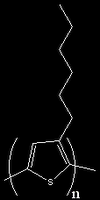Organic solar cells in plain english--part three
In order to explain why organic solar cells don't last so long, a little chemistry background is in order. As I said in Part One, most carbon-based semiconductors are p-type materials.[1] These can be polymers or smaller molecules. P3HT, MEH-PPV, MDMO-PPV ...the list goes on.
Hmm, what do these have in common? Alkyls or alkoxies on an aromatic ring? These are swimming in electron density.
This can be a bit of a problem if you have the solar cells open to air, especially considering that they contain these fluffy-with-electrons polymers next to C60. C60, in addition to being a decent material for use in the active layer of a solar cell, is also a photosensitizer. Oops.
[2]Photosensitizers (P) are materials that absorb energy from light. The energy they absorb puts them in an electronically excited state (P*). P* can then react with other materials, say, O2, to produce O2*, infamous as singlet oxygen.[3] Uh-oh. Singlet oxygen is hella reactive. Unlike ground-state oxygen, it can readily oxidize organics.
Think of it as a shark, but moreso after electrons than blood.
So you get a 1,2-dioxetane, which usually ends up as the ketone, or an endoperoxide, which ends up as the quinone.[4] Apply this to the aforementioned electron-fluffy polymers, and you get...a dead solar cell. Sadness.
Another way to kill your carbon-based solar cells is to expose them to moisture. The PEDOT:PSS layer is hygroscopic. After the PEDOT:PSS adsorbs a little water, the device becomes resistive.[5]
There you have it--things that kill solar cells. The best way to get around this at the moment is to encapsulate the devices so that oxygen and water (well, humid air) can't get to them. Granted, that's more an engineery thing. Chemists are in it to make more stable materials...which is kinda tricky. Maybe I'll post more of this. Maybe not.
[1] Unless you are Tobin Marks, in which case you have oligothiophenes with fluorinated alkyl or aryl stuff stuck on. Check out JACS 2005, 127, 1348-1349 for one example.
[2] Unlike solid-state physics, I would KILL to get into photophysics in more depth. But this is still in plain english. A promise, though: Catastrophe aside, you WILL see more photophysics in here, with gory details to accompany.
[3] Mwahaha!
[4] Well, it won't quite work with the substrates I have shown...singlet oxygen reactions usually require CRAZY electron density.
[5] Solar Energy Materials & Solar Cells 2006, 90, 3520-3530. Can I just say that it's nice to read a paper every once in awhile that I can get through without having to reread every other line because the writing is overly thick and technical? Thank you very much to the authors. Ahhhh.




2 comments:
Swager published polyfluorinated PPVs in 2004 or so. There was a JACS paper. These polymers were very difficult to photobleach and even TFA wouldn't kill them.
OOH! i'll have to check that out! *excited*
Post a Comment